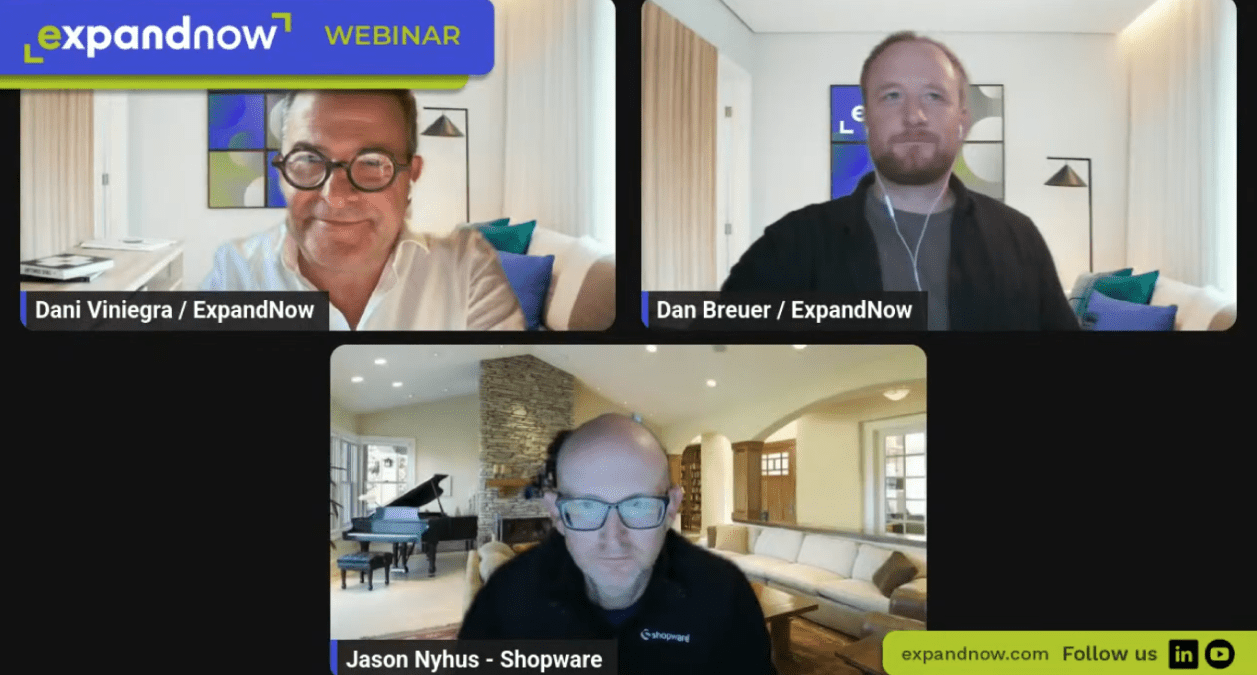- Post
How to Expand Ecommerce Internationally: 6 Insights from Our Latest Webinar
International expansion is no longer optional for ambitious ecommerce brands—it’s essential. But here’s the challenge: most merchants approach global growth the wrong way, treating each new market as a one-off project that drains resources and delays profitability.
In our recent webinar, Jason Nyhus (President & GM at Shopware North America) and Dan Breuer (CCO at ExpandNow) broke down exactly how to scale internationally without sacrificing margins or momentum. If you missed the live session, here are the six critical takeaways every ecommerce leader needs to know.
1. Cross-Border Digital Commerce Is Growing 2-4x Faster Than Digital Commerce
“Cross-border digital commerce is usually anywhere from two to four times faster growing than digital commerce in general.” – Dan Breuer, CCO at ExpandNow
The data tells a clear story: while retail commerce grows at 0-5% annually and digital commerce at 5-10%, cross-border digital commerce is accelerating at 2-4x that rate. This isn’t a trend—it’s a fundamental shift in how consumers shop globally.
Why the explosive growth? Consumers can now buy from brands anywhere in the world as easily as they shop locally. Social platforms like TikTok Shop and Instagram have made brands globally relevant overnight, eliminating the traditional retail distribution barriers.
The bottom line: If your products have appeal beyond your home market, international expansion should be a top-five strategic priority.
2. Most Brands Are Unprepared for the Complexity of Global Expansion
“The first thing people come in with is a strong bias towards trying to use what they already have in place… but you can’t just take what’s built for one market and simply try to land it in another.” – Jason Nyhus, President & GM at Shopware North America
Here’s the uncomfortable truth: most brands underestimate what it takes to sell internationally. They assume they can simply extend their existing payment processor, tax system, and fraud tools to new markets.
But international commerce introduces entirely new challenges:
- Tax obligations in countries where you have no physical presence
- Local payment methods your US-based processor doesn’t support
- Compliance requirements that vary dramatically by market
- Fraud patterns and acceptance rates you’ve never encountered
The brands that succeed are the ones who approach international expansion as a new capability to build—not just an extension of what they already have.
3. The Profitability Math Is Often Upside Down
“When you operate at scale—a hundred million dollars—and you have a team to support that business, now you need to do the same amount of business processes to support something that is roughly five percent of the same market.” – Jason Nyhus, Shopware
Here’s the paradox: the upfront cost of international expansion is often disproportionate to the initial revenue opportunity.
A $100M brand expanding into five new markets might only generate an additional 5% revenue initially. But the operational lift—legal entities, tax compliance, payment infrastructure, customer service in new languages—requires nearly the same resources as their entire $100M operation.
This is why so many international expansion projects stall. The business case simply doesn’t work when you’re building everything from scratch for each market.
The solution: Find partners and platforms that let you redeploy capabilities across markets, rather than rebuilding from zero each time.
4. Merchant of Record: The Fast Track to International Markets
“By using Merchant of Record, you’re essentially shifting that complexity to a third party provider… so you can focus on the things that are strategic to your business, like your products and your customers and your content.” – Dan Breuer, ExpandNow
Most merchants have never heard of Merchant of Record (MoR), but it’s been solving international expansion challenges for over 20 years—starting with software companies who needed to distribute digital products globally.
Here’s how it works: You appoint a third-party provider to act as the legal merchant on your behalf in international markets. They handle payments, tax compliance, fraud management, and regulatory requirements while you maintain complete control of your branded customer experience.
What Merchant of Record handles for you:
- Tax registration and compliance in every market
- Local payment method acceptance
- Fraud screening and liability
- Currency conversion at competitive rates
What you keep control of:
- Your brand experience
- Product catalog and pricing strategy
- Marketing and customer acquisition
- Customer relationships
Think of it like “employer of record” for payroll or “importer of record” for logistics—proven business models applied to ecommerce.
5. Test and Learn Without Six-Month Implementation Projects
“One of the most important parts about choosing the right solutions is that it’s got to work in a test and learn environment… you don’t have to make a huge upfront investment to go do that test and learn.” – Dan Breuer, ExpandNow
Here’s where most international expansion projects fail: brands are asked to commit six months and significant capital to enter a market where revenue is highly uncertain.
That’s a terrible business case.
The modern approach is bite-sized expansion:
- 1. Start with 1-3 markets where you already have demand signals (website traffic, social followers, marketplace success)
- 2. Launch quickly using platforms and partners designed for multi-market commerce
- 3. Learn what works before scaling to additional markets
- 4. Redeploy your playbook to the next tier of countries
Ideal candidate profile for Merchant of Record:
- Selling $1M+ annually through ecommerce
- Products with international appeal and existing demand signals
- Mid-market companies who don’t have endless resources like enterprises
- Brands who want to test new markets without building permanent infrastructure
6. Focus on Strategic Activities, Outsource Tactical Complexity
“Tax is one of those areas that is almost never strategic for businesses… Brands think: I would be much better suited to focus on marketing or my new product launch or this campaign I’m about to roll out.” – Dan Breuer, ExpandNow
Here’s the framework for deciding what to build yourself versus what to outsource:
Strategic (keep in-house):
- Product development and merchandising
- Customer experience and website design
- Marketing strategy and content creation
- Pricing and promotion strategy
Tactical (consider outsourcing):
- Tax registration and filing
- Payment method integrations
- Fraud screening and chargeback management
- Currency conversion and FX optimization
- Regulatory compliance monitoring
Most brands make the mistake of trying to do everything themselves, spreading their team thin across both strategic and tactical work. The winners focus their energy on what drives growth and partner with specialists for operational complexity.
The Hidden Margin Killers in International Commerce
Beyond the strategic insights, Dan shared three tactical ways brands unknowingly erode 2-4% of their international GMV:
1. Foreign Exchange Rates
Many payment providers and Merchant of Record solutions monetize heavily on FX conversion. Brands often don’t realize they’re paying 2-3% above market rates just to convert currencies.
2. Cash Flow Timing
Traditional Merchant of Record models pay out on 30-day terms. That delayed cash flow has a real financial cost—roughly 50 basis points in today’s economy—because you can’t reinvest that capital into inventory or marketing.
3. High Upfront Fixed Costs
Projects that require hundreds of thousands in upfront investment often don’t become profitable until year three or four. Modern solutions should have minimal cash investment upfront so you can be profitable within months.
At $5M in international revenue, recovering 2-4% means $100K-$200K annually—real budget you could reinvest in inventory, marketing, or your next market entry.
What Platform Capabilities Matter Most
“Look for commerce platforms that don’t charge a revenue share on the software itself… and provide unlimited channels as part of your relationship.” – Jason Nyhus, Shopware
When evaluating ecommerce platforms for international expansion, focus on:
Multi-site, multi-storefront architecture:
Manage multiple countries from a single backend without paying per additional site. Avoid platforms that force you to create separate instances for each market.
Open ecosystem:
Access to best-in-class apps and extensions for payments, tax, fraud, and merchant of record. Don’t get locked into a platform’s preferred commercial relationships.
Flexible provider support:
The ability to use different solutions in different markets. You might be your own merchant in the US but use merchant of record in the EU—your platform should support both models elegantly.
No revenue-share tax:
Platforms that charge a percentage of GMV create a “tax on your growth.” Look for subscription-based pricing that scales with your needs, not your revenue.
Where to Start: Market Selection Strategy
When asked which markets brands should prioritize, both Jason and Dan emphasized two key factors:
1. Follow demand signals:
- Website traffic from specific countries
- Social media followers and engagement by geography
- Marketplace success (Amazon, TikTok Shop) in certain regions
2. Start culturally similar:
- US brands should consider: UK, Canada, Australia, then Western Europe
- The further from home, the more complex commerce becomes
- Cultural similarity reduces operational complexity
Pro tip: Many brands use marketplace success as a “trail guide” for where to build direct-to-consumer channels. If you’re selling well on Amazon UK, that’s a signal to invest in your own DTC presence there.
Watch the Full Webinar
Want to hear the complete discussion with all the details, examples, and live Q&A? Watch the full recording here
Ready to Expand Internationally?
ExpandNow and Shopware make international expansion simple, fast, and profitable.
Explore our solutions:
Shopware Extension: Seamless integration with your Shopware store.
Request a Demo: See how ExpandNow works for your business
Shopware Partnership: Learn more about our collaboration
Have Questions or Want Support? Get in touch with us today.




